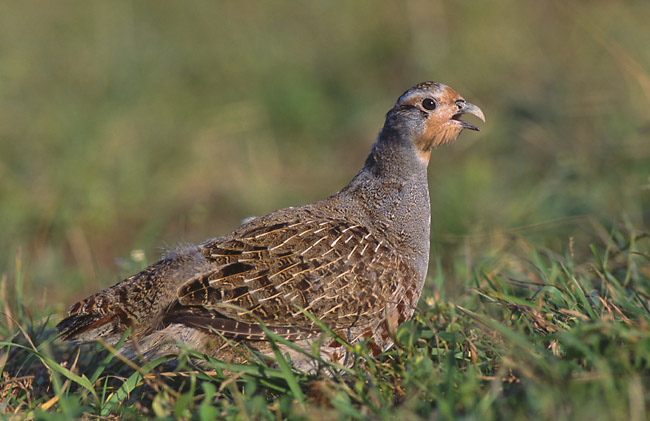|
| 질의: gray partridge | 결과: 1번째/49 | |
Grey Partridge (Perdix perdix) - Wiki
| 제목: | Grey Partridge (Perdix perdix) - Wiki
| |

| 해상도: 650x421
파일크기: 97271 Bytes
촬영일: 2004:11:21 22:52:59
등록시간: 2007:09:24 07:59:47
|
Grey Partridge
From Wikipedia, the free encyclopedia
[Photo] Grey Partridge (Perdix perdix). Author: Marek Szczepanek (http://commons.wikimedia.org/wiki/User:Pkuczynski/Marek_Szczepanek) Copyright (C) Marek Szczepanek
Permission is granted to copy, distribute and/or modify this document under the terms of the GNU Free Documentation License, Version 1.2 or any later version published by the Free Software Foundation; with no Invariant Sections, no Front-Cover Texts, and no Back-Cover Texts. A copy of the license is included in the section entitled "GNU Free Documentation License". |
The Grey Partridge, Perdix perdix also known as Hungarian Partridge or Hun is a gamebird in the pheasant family Phasianidae of the order Galliformes, gallinaceous birds.
This partridge breeds on farmland across most of Europe into western Asia, and has been introduced widely into North America and are quite common in some areas of southern Canada and the northern United States. Hens lay up to twenty eggs in a ground nest. The nest is usually in the margin of a cereal field, most commonly Winter wheat. It is a non-migratory terrestrial species, which forms flocks outside the breeding season.
It is declining greatly in numbers in areas of intensive cultivation such as Great Britain, due to loss of breeding habitat and food supplies. The numbers have fallen by 85% in the last 25 years. Efforts are being made in Great Britain by organisations such as the Game Conservancy Trust to halt the decline by creating Conservation headlands. In 1995 it was nominated a Biodiversity Action plan species (see UK BAP).
The Grey Partridge is a rotund bird, 28-32 cm long, brown-backed, with grey flanks and chest. The belly is white, usually marked with a large chestnut-brown horse-shoe mark in males, but also in many females. The only major and constant difference between the sexes is the so-called cross of Lorraine on the tertiary coverts of females - these being marked with two transverse bars, as opposed to the one in males. These are present after around 16 weeks of age when the birds have moulted into adult plummage. Young Grey Partridges are esentally yellow-brown, and lack the distinctive face and underpart markings. The song is a harse kieerr-ik.
When disturbed, like most of the gamebirds, it flies a short distance on rounded wings, often calling rick rick rick as it rises.
This is a seed-eating species, but the young in particular take insects as an essential protein supply. During the first 10 days of life, the young can only digest insects. The parents lead their chicks to the edges of cereal fields, where they can forage for insects.
Widespread and common throughout its large range, the Grey Partridge is evaluated as Least Concern on the IUCN Red List of Threatened Species.
The species has been successfully introduced to many parts of the world for shooting, including vast areas of north America where it is most commonly known as Hungarian partridge, or just plain "Hun".
http://en.wikipedia.org/wiki/Grey_Partridge
| The text in this page is based on the copyrighted Wikipedia article shown in above URL. It is used under the GNU Free Documentation License. You may redistribute it, verbatim or modified, providing that you comply with the terms of the GFDL. |
|
^o^
동물그림창고 똑똑전화 누리집
^o^
|
|